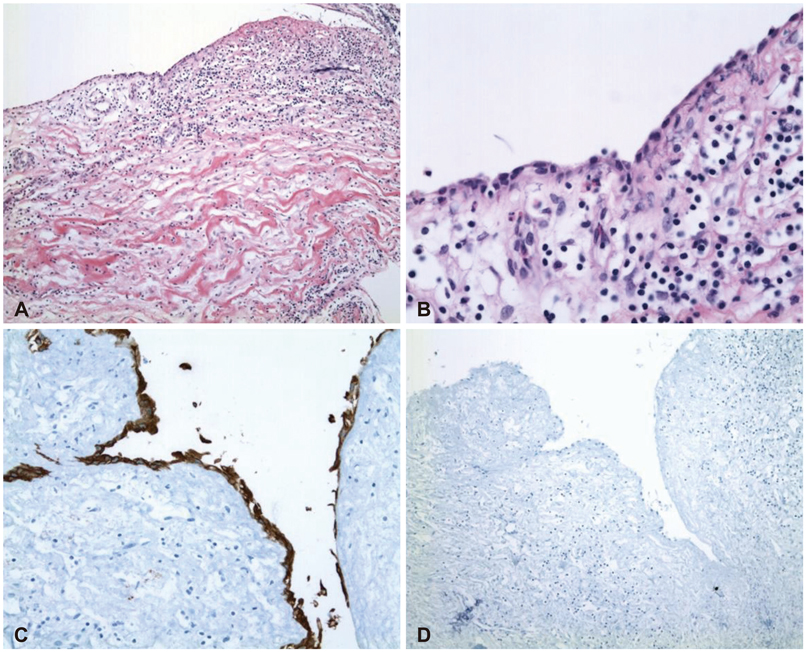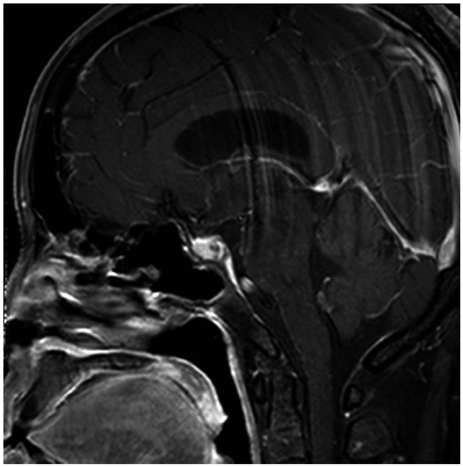Brain Tumor Res Treat.
2013 Apr;1(1):28-31. 10.14791/btrt.2013.1.1.28.
Inflamed Symptomatic Sellar Arachnoid Cyst: Case Report
- Affiliations
-
- 1Department of Neurosurgery, Seoul National University, Seoul, Korea.
- 2Neurooncology Clinic, National Cancer Center of Korea, Goyang, Korea. nsghs@ncc.re.kr
- 3Department of Pathology, National Cancer Center of Korea, Goyang, Korea.
- 4Department of Radiology, National Cancer Center of Korea, Goyang, Korea.
- KMID: 2165219
- DOI: http://doi.org/10.14791/btrt.2013.1.1.28
Abstract
- Sellar arachnoid cysts are rare; an infected arachnoid cyst is extremely rare as only one case has been reported to date in the literature. Here, we report a patient with an infected or inflamed sellar arachnoid cyst that was successfully treated with transsphenoidal surgery (TSA). A 53-year-old female with a history of chronic sinusitis developed a headache 5 months ago, and one month before admission polyuria, polydipsia, and abnormal vaginal bleeding occurred. The magnetic resonance imaging (MRI) showed a sellar cystic mass with a thickened pituitary stalk. Preoperative hormonal study revealed normal pituitary hormone levels except for a moderate elevation of prolactin. She was diagnosed with diabetes insipidus of the central nervous system origin based on a water-deprivation test. TSA was performed under an impression of symptomatic Rathke's cleft cyst according to the MRI findings. Intraoperative findings showed confirmation of turbid intracystic contents, but micro-organisms were unidentified on microbial culture. Pathology of the cyst wall revealed inflamed meningoepithelial lining cells compatible with an arachnoid cyst.
Keyword
MeSH Terms
Figure
Reference
-
1. Eskandary H, Sabba M, Khajehpour F, Eskandari M. Incidental findings in brain computed tomography scans of 3000 head trauma patients. Surg Neurol. 2005; 63:550–553. discussion 553.
Article2. Katzman GL, Dagher AP, Patronas NJ. Incidental findings on brain magnetic resonance imaging from 1000 asymptomatic volunteers. JAMA. 1999; 282:36–39.
Article3. Weber F, Knopf H. Incidental findings in magnetic resonance imaging of the brains of healthy young men. J Neurol Sci. 2006; 240:81–84.
Article4. Rengachary SS, Watanabe I. Ultrastructure and pathogenesis of intracranial arachnoid cysts. J Neuropathol Exp Neurol. 1981; 40:61–83.
Article5. Dubuisson AS, Stevenaert A, Martin DH, Flandroy PP. Intrasellar arachnoid cysts. Neurosurgery. 2007; 61:505–513. discussion 513.
Article6. Miyajima M, Arai H, Okuda O, Hishii M, Nakanishi H, Sato K. Possible origin of suprasellar arachnoid cysts: neuroimaging and neurosurgical observations in nine cases. J Neurosurg. 2000; 93:62–67.
Article7. Rohrer DC, Burchiel KJ, Gruber DP. Intraspinal extradural meningeal cyst demonstrating ball-valve mechanism of formation. Case report. J Neurosurg. 1993; 78:122–125.
Article8. Sivaraman V, Au-Yeung A, Brew S, McEvoy AW, Greenwood R. An infected arachnoid cyst in an elderly patient. J Neurol. 2008; 255:1088–1089.
Article9. Shin JL, Asa SL, Woodhouse LJ, Smyth HS, Ezzat S. Cystic lesions of the pituitary: clinicopathological features distinguishing craniopharyngioma, Rathke's cleft cyst, and arachnoid cyst. J Clin Endocrinol Metab. 1999; 84:3972–3982.
Article10. Miyamoto T, Ebisudani D, Kitamura K, Ohshima T, Horiguchi H, Nagahiro S. Surgical management of symptomatic intrasellar arachnoid cysts--two case reports. Neurol Med Chir (Tokyo). 1999; 39:941–945.
Article




